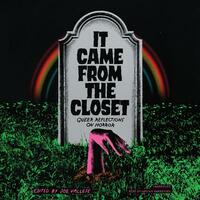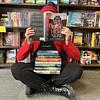You need to sign in or sign up before continuing.
Take a photo of a barcode or cover
emotional
informative
inspiring
mysterious
reflective
medium-paced
informative
funny
reflective
medium-paced
emotional
funny
informative
inspiring
reflective
relaxing
medium-paced
challenging
emotional
hopeful
informative
inspiring
mysterious
reflective
medium-paced
"Horror helped me love my terrible truths, the things about me that disquieted others. Amid the mayhem and the viscera, signposts pointing to queer futures." p.19
I really wanted to finish this in June, but I'm only a few days shy of that goal. This read features a collection of queer and trans writers as they use horror films to understand better their lives, identities, sexualities, and their presentation to the world overall. It introduced me to some new movies as well as giving me additional ways to read movies I've already seen. It's raw and unapologetic, and I loved it. If they introduce a part 2 with another round of authors and films, I would be first in line to grab a copy. This is one of the better collections of essays/reflections that I've read. Highly recommend but definitely be aware of triggers because these essays do reflect on real people and real issues.
Other Quotes:
- "If you want the rewards of being loved, you must submit to the mortifying ordeal of being known." pp.76-77
- "Unlike fear — which is a response to immediate threat — anxiety is, according to critic Mathias Clasen in Why Horror Seduces, 'a future-oriented emotion, an emotion that occurs in response to anticipations of danger or threat.'" p.129
- "To be queer is to be a wound." p.248
- "As Sontag says, 'We are better able to enjoy a fantasy as fantasy when it is not our own.'" p.284
I really wanted to finish this in June, but I'm only a few days shy of that goal. This read features a collection of queer and trans writers as they use horror films to understand better their lives, identities, sexualities, and their presentation to the world overall. It introduced me to some new movies as well as giving me additional ways to read movies I've already seen. It's raw and unapologetic, and I loved it. If they introduce a part 2 with another round of authors and films, I would be first in line to grab a copy. This is one of the better collections of essays/reflections that I've read. Highly recommend but definitely be aware of triggers because these essays do reflect on real people and real issues.
Other Quotes:
- "If you want the rewards of being loved, you must submit to the mortifying ordeal of being known." pp.76-77
- "Unlike fear — which is a response to immediate threat — anxiety is, according to critic Mathias Clasen in Why Horror Seduces, 'a future-oriented emotion, an emotion that occurs in response to anticipations of danger or threat.'" p.129
- "To be queer is to be a wound." p.248
- "As Sontag says, 'We are better able to enjoy a fantasy as fantasy when it is not our own.'" p.284
Graphic: Homophobia, Transphobia, Violence
Moderate: Body horror, Racism, Sexism, Sexual assault, Sexual content, Dysphoria
Minor: Adult/minor relationship, Alcoholism, Pedophilia, Pregnancy, Alcohol
reflective
slow-paced
This is a collection of personal essays explicating each authors' relationship to the horror genre. As with any essay collection there were some brilliant and insightful pieces in here and some that didn't resonate with me.
The standout essays from this collection are "On Beauty and Necrosis" by Sachiko Ragosta and "Indescribable" by Carrow Narby.
In "On Beauty and Necrosis", Ragosta discusses their queer experience through the lens of the film Eyes Without A Face, in which a doctor holds his disfigured daughter captive in their family home while searching for a beautiful woman whose face he can transplant onto hers. Ragosta is interested in the metaphor of the mask as it related to transness, specifically the nonbinary experience.
[Her father] reduces her to her ability to fit into hegemonic standards of beauty, disinterested in the other parts of her that remain unmarred. In this way, Eyes Without a Face can be read as a subversion of the stories that paint trans people as masked murders (see: Dressed to Kill, Psycho, The Silence of the Lambs, Sleepaway Camp, etc.) - tricksters hiding some imagined biological truth. Trans people are reduced to our ability to fit some imagined but collectively reinforced standards of gender.
Transness to Rogosta is unmasking. In order to move through a binary gendered society we are expected to adopt one of the binary genders and constantly maintain a performance of it, just as Christaine of the film is expected to wear her mask around the house to get used to wearing it in public. "It is violent to ask trans people to mask ourselves so it is easier for others to "understand" us, and this is not understanding at all."
In "Indescribable", Narby discusses their experiences as agender and why they are compelled by the amorphous creatures of The Blob and Society.
We know what woman is because, in any given context where man and woman are conceptualized, we can define the boundary of what is and is not man. We can name homosexuality because we can contrast it with heterosexuality. We develop a sense of self because we can recognize that which is outside of or apart from ourselves. But what if those distinctions were permeable? What if they collapsed entirely?…An all-consuming blob is about the most literal representation of the collapse of meaning that I can imagine.
The blob represents perfect permeability and, to Narby, tantalizes with an idea of perfect understanding and unity. This wish for perfect unity emerges from Narby's absence of gender: "Gender, among its other applications, is the primary framework through which desire and romantic intimacy are understood." To understand desire and intimacy without the gender binary it is necessary to first understand that we absorb our ideas about what love is through a binary framework. Narby wonders if love is even legible to the dominant culture as love without this framework, which is something I had never considered in quite this way. I myself have often been preoccupied with the idea of intimacy that transcends the physical body through permeability and I found this essay revelatory.
Other worthwhile essays in this collection are
- "The Girl, The Well, The Ring" by Zephyr Lisowski about The Ring and Pet Sematary, which discusses her view of the interplay between disability and transfemininity
- "Three Men On A Boat" by Jen Corrigan about Jaws, which persuades the reader to look at subtextual queer readings as valuable to the invisibility/erasure of bisexuality
- "Twin/Skin" by Addie Tsai about Dead Ringers, which details her connection to the movie as an estranged twin
- "Centered and Seen" by Sumiko Saulson about Candyman, which discusses connecting to the queer community through horror despite the community's overwhelming whiteness and finding a place there, and
- "Bad Hombre" by Sarah Fonseca about "Eres tu, papa?", a Cuban horror film about the relationship between fathers and daughters under racialized patriarchy, and how that is influenced by rural poverty brought on by colonial oppression.
I'd recommend this book to anyone who like personal essays, or to horror fans who have ever found themselves grappling with what it means to see ourselves in a genre that oftentimes hates us.
what a slay! so so interesting and intersectional in the way it blended queer and horror media
challenging
dark
emotional
funny
hopeful
informative
inspiring
reflective
tense
emotional
informative
reflective
slow-paced







